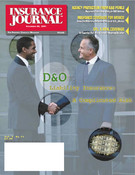If gender is eliminated from the factors Kentucky insurers use to determine auto rates, youthful female drivers state-wide would pay 6.8 percent more for their auto insurance premiums, according to a recent study.
The National Association of Independent Insurers (NAII) stated that Kentucky lawmakers are exploring that possibility, along with others, as they seek answers from the property/casualty insurance industry about why male drivers under 25 in the state pay more than females for combined liability and collision auto coverage.
The Bluegrass State is one of 43 states that permit gender-based risk classification for auto insurance, and Kentucky lawmakers cannot change this practice until the full Assembly convenes for the 2002 legislative session in January.
Although, under Texas law, an insurance company cannot discriminate because of age, gender, marital status, geographic location, disability or partial disability, until the age of 25 young men pay higher auto insurance rates than young women. This is allowable if the refusal, limitation, or higher rate is “based on sound underwriting or actuarial principles.” In other words, if the company has valid evidence that an individual or a class presents greater risk for a loss than other drivers it is willing to insure, it may assess a higher rate or otherwise limit access to insurance coverage to those individuals.
National statistics gathered by NAII seem to support insurers’ practice of differentiating insurance rates between young males and females. According to an October 2000 study by the Insurance Institute for Highway Safety, two out of every three teen-agers killed in motor vehicle crashes in 1999 were males. Death rates in 1999 for male drivers age 16 to 19 more than doubled the rate for females in the same age category (22 per 100,000 people were young male drivers while 11 per 100,000 people were young female drivers), according to the IIHS.
The rate of nighttime fatal crashes per 100 million miles traveled in 1995-96 by male drivers 16 to19 years old was about four times the rate for 30-to 54-year-old male drivers. The corresponding comparison for females is more than three times the rate.
Also, 2000 figures released by the National Highway Traffic Safety Administration and 1999 data from the Federal Highway Administration show that 71 to 72 percent of drivers age 15-20 involved in fatal crashes were male.
Robert Hurns, counsel for the NAII, testified at the Kentucky Interim Joint Committee on Banking and Insurance that if gender was removed as a factor, a hike in premiums for female drivers would be unfair since male drivers are involved in fatal accidents 50 percent more often than female drivers. Hurns added that if gender bias is removed, “the insurance premium increase imposed on young female drivers would be slightly higher than the decrease given to male drivers.”
Females, who make up half of the youthful driving population, would shoulder a 6.8 percent increase in their liability and collision premiums to subsidize a 6.1 percent premium decrease given to young male drivers, Hurns noted.
The NAII, along with the Kentucky Farm Bureau and State Farm Insurance, testified that if lawmakers alter gender-based rating, the inevitable outcome would be restrictions of insurance availability and affordability for higher risk policyholders—such as young male drivers.
Members of the three groups told the legislative committee that the sex, age and marital status of a driver as well as the vehicle make and model, and where the car is garaged are all factors used as rating criteria.
“These factors are all statistically proven to be practical, justifiable and equitable methods of allocating policyholder costs,” Hurns told the lawmakers.
According to a recent NAII analysis of loss experience in Kentucky, it costs private passenger auto insurers about 16 percent more to offer liability protection to young male drivers than to young females ($537 versus $462) and 11 percent more to offer collision coverage to young males versus females ($369 compared to $332).
Overall, the amount of loss per insured car incurred by a young male in Kentucky is 14 percent higher than loss incurred by a young female, resulting in a combined liability and collision coverage loss costs difference of $904 for males under 25 and $795 for females under 25.
“All of this data proves that accidents caused by boys are more deadly and costly, which warrants higher rates being charged to the male group of drivers in Kentucky,” Hurns said. “Insurers must base their premiums on cost, which is why it is necessary for insurers to differentiate between classes of varying accident likelihood, such as gender.”
Topics Carriers Auto Legislation Kentucky
Was this article valuable?
Here are more articles you may enjoy.


 Marsh McLennan Agency to Acquire The Horton Group
Marsh McLennan Agency to Acquire The Horton Group  The Battle Over J&J’s Bankruptcy Plan to End Talc Lawsuits
The Battle Over J&J’s Bankruptcy Plan to End Talc Lawsuits  Beryl’s Remnants Spawned 4 Indiana Tornadoes, Including an EF-3: NWS
Beryl’s Remnants Spawned 4 Indiana Tornadoes, Including an EF-3: NWS  What Happened to Reinsurance ‘Class of 2023’? Hard Market Defies Age-Old Patterns.
What Happened to Reinsurance ‘Class of 2023’? Hard Market Defies Age-Old Patterns. 


